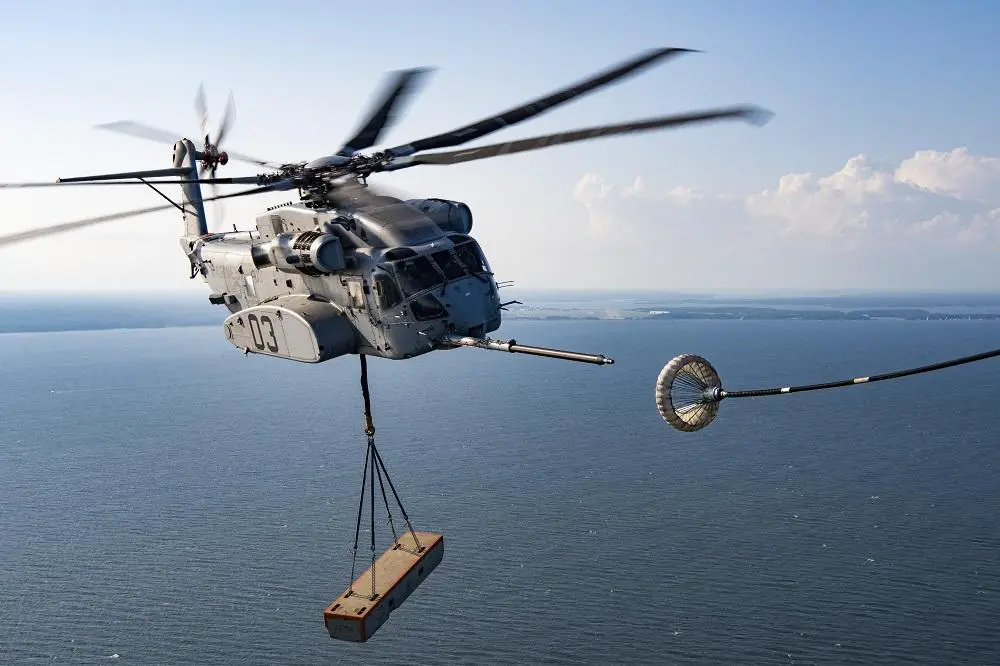A full authority digital fly-by-wire Flight Control System (FCS) is one of many impressive capabilities setting the CH-53K King Stallion heavy lift helicopter apart from any other heavy lift aircraft. “Full authority” means the FCS provides all of the aircraft motion – not just supplementing the pilot for stability. A digital fly-by-wire FCS is an electronic flight control system teamed with a digital computer that replaces mechanical control systems in an aircraft. It makes the aircraft easier to handle in degraded visual environments at gross weights up to 88,000 lbs. The CH-53K is currently cleared to 27,000 lbs. external lift but will eventually be cleared to 36,000 lbs. The high performance of the FCS is a direct result of the ongoing collaboration and cooperation between subject matter experts within the Naval Air Systems Command (NAVAIR) Heavy Lift Helicopters Program Office (PMA-261), the Integrated Test Team (ITT), and the Flight Controls System design engineers from Sikorsky, a Lockheed Martin Company.
“FTVs are an extremely powerful tool. It allows us to test design fixes on aircraft in between major software releases. this means the team can continually improve the FCS software. If an issue is identified in flight test, the FTVs can be adjusted within a preapproved range, providing the pilots an opportunity to evaluate the correction in the aircraft in the intended environment. These FTVs are then incorporated into the next major FCS software release. With each major FCS software drop, the aircraft baseline performance markedly increases due to the incorporation of these verified FTVs,” said Craig Merriman, CH-53K assistant program manager for test.
“The CH-53E/D were much harder to fly. And the ease of flying this, the flight control system is probably the biggest game changer for the 53 community. We’re not used to anything like this,” said retired Lt. Col. Lucas Frank, formerly of Marine Operational Test and Evaluation Squadron 1 (VMX-1).

For pilots, the FCS provides more predictable and stable control responses to improve safety and mission effectiveness. For maintainers, the FCS reduces complexity by eliminating conventional helicopter hardware like mixers, push-rods and tail rotor cables, while improving diagnostic capability and maintenance time. For members of the CH-53K ITT, the most impressive FCS benefit is how it can be used to achieve future capabilities and quickly correct identified deficiencies. The flight test program for the CH-53K uses four Engineering Development Model (EDM) CH-53K aircraft. In these four test aircraft, the fly-by-wire FCS permits the use of adjustable parameters called Flight Test Variables (FTVs), giving the test team opportunities to improve the aircraft control characteristics. The CH-53K FCS is a work in progress and a team effort. When issues were identified through flight test, which required a quick resolution, the whole team collaborated from sites in Florida, Maryland and Connecticut. One example of the team’s success was the correction of air data faults during aerial refueling. During initial aerial refueling testing on the CH-53K in 2018, the FCS showed faults due to the turbulent air data created by the tanker aircraft.
The FCS air data computers were reading large pressure fluctuations causing the FCS to think the air data computers had failed. With the deficiency identified by the flight test team, the design engineers began developing FTVs and performing analysis. The FTVs were evaluated in the Flight Controls System Integration Lab (FCSIL), a Sikorsky-owned lab in Stratford, CT, used by the ITT. The FCSIL is a CH-53K aircraft representative laboratory and simulator with triplex redundancy – a flight representative control system. The facility is used to simulate aircraft behavior and evaluate the aircraft performance relative to new FTVs. The facility is also used to verify the safe load and unload of FTVs to the software. Following the FCSIL testing, the NAVAIR Airworthiness group reviewed the analysis and granted approval to fly the FTVs. With this approval, the test team loaded the FTV on the aircraft. The fix was tested with no degradation, permitting the fleet aerial refueling operations which are in use today. The use of FTVs has been key in resolving FCS deficiencies discovered during flight test and will be used to enhance the already successful fly-by-wire system as the CH-53K takes on additional capabilities in the future.
















